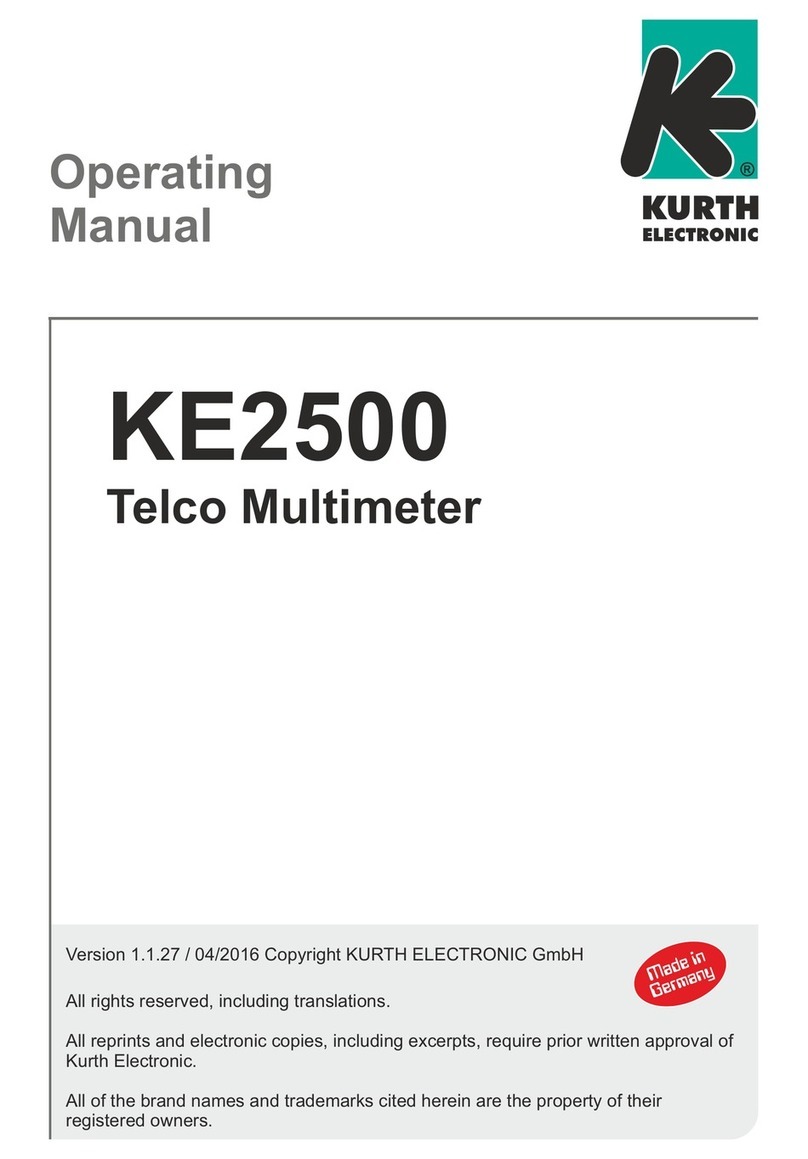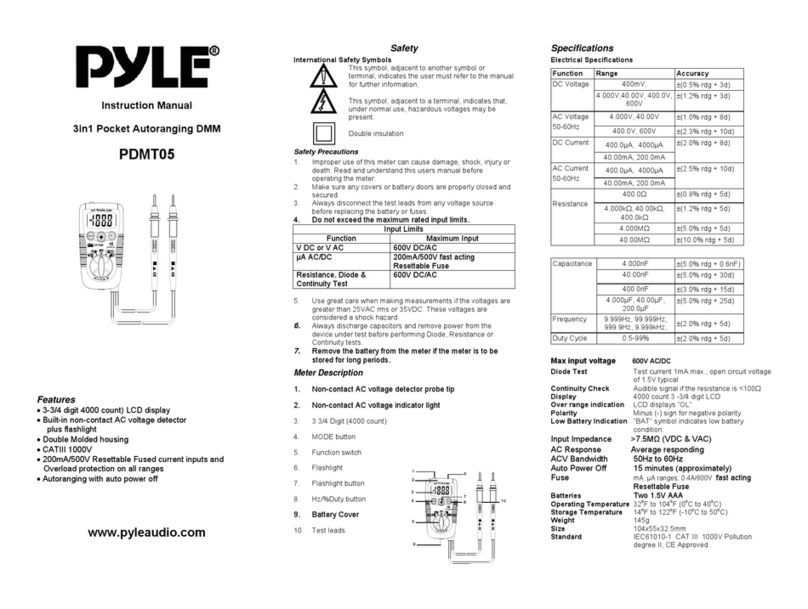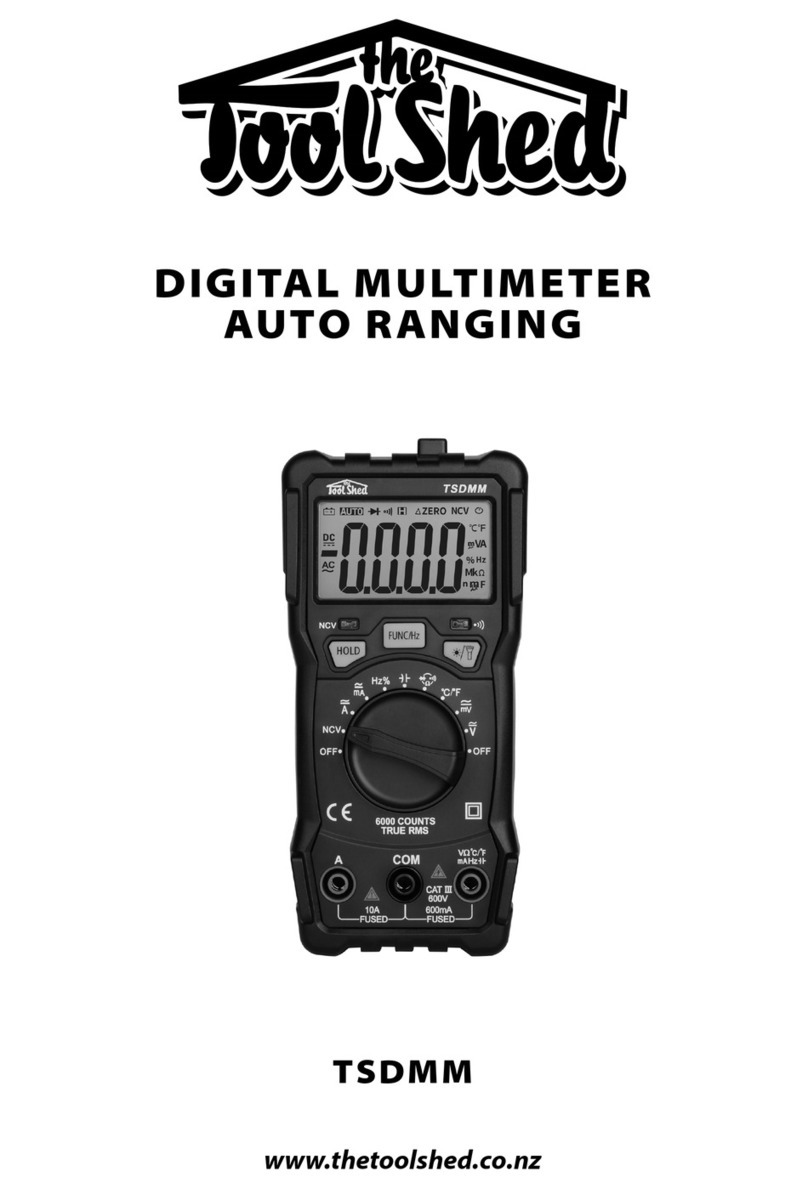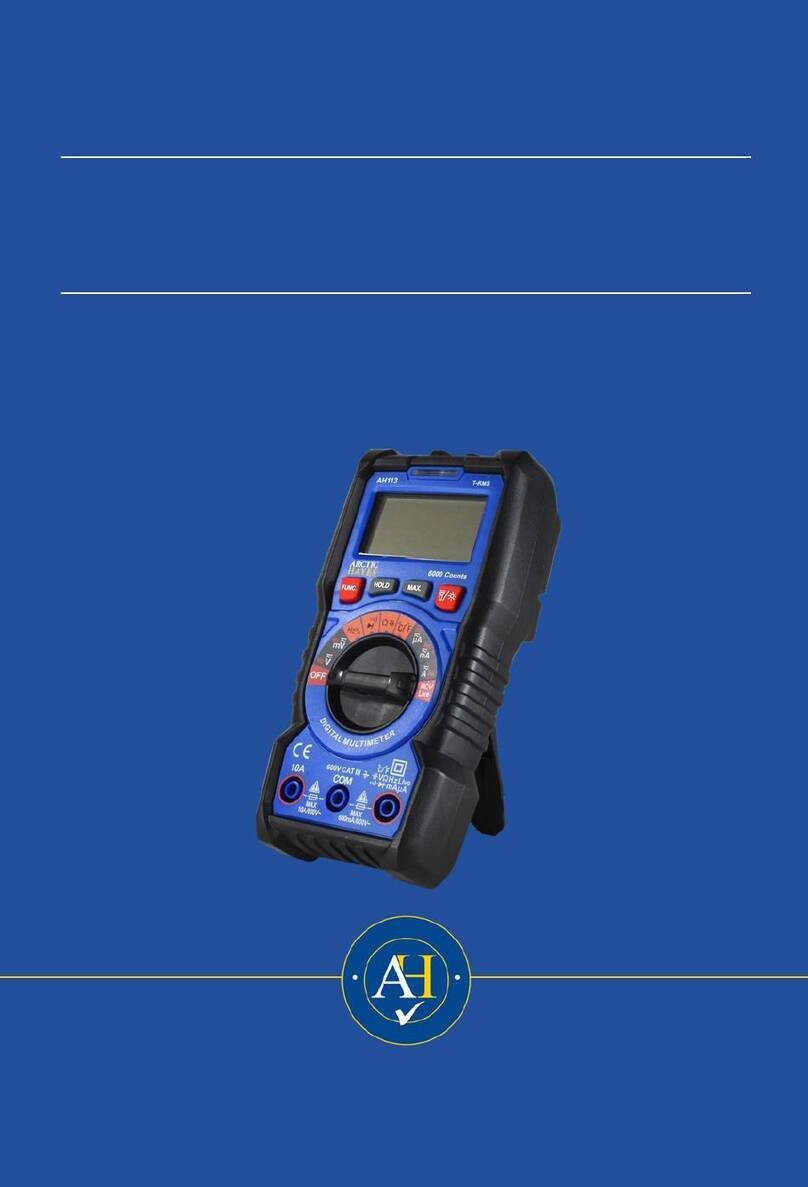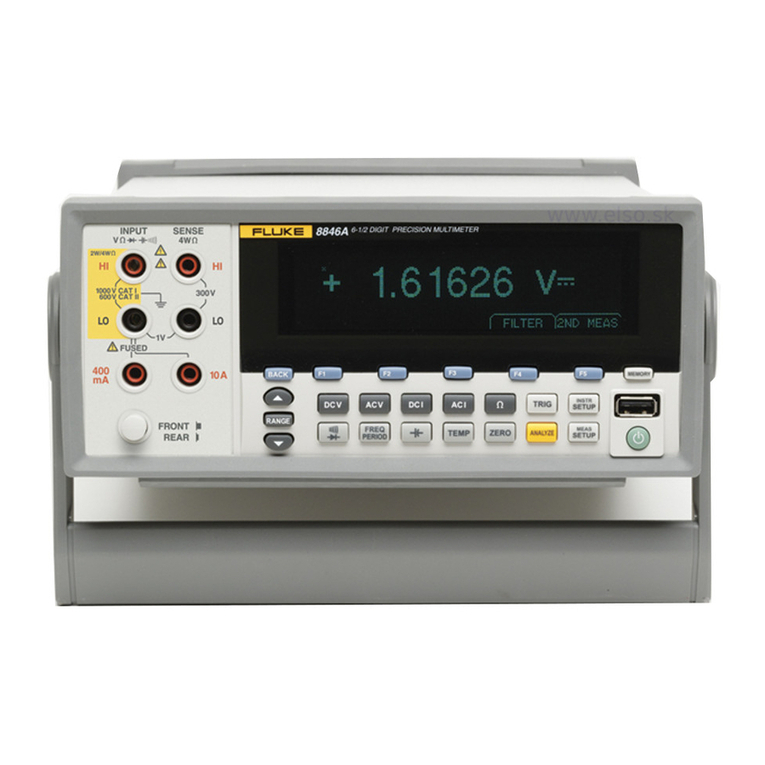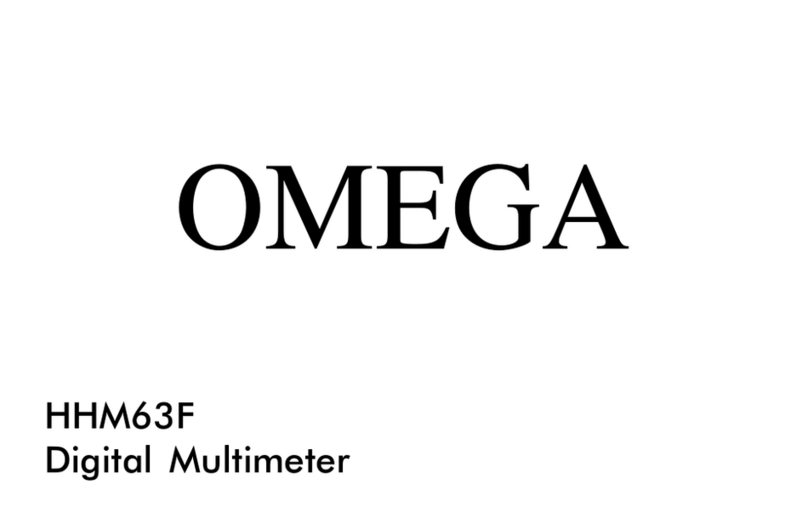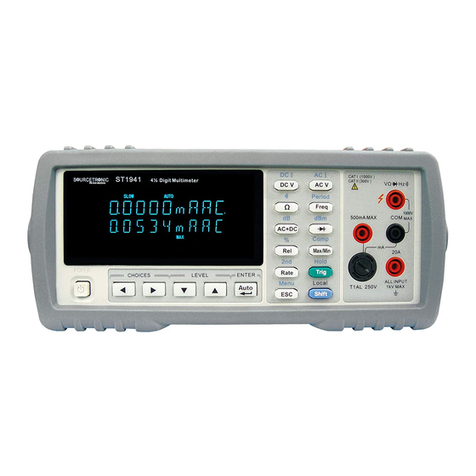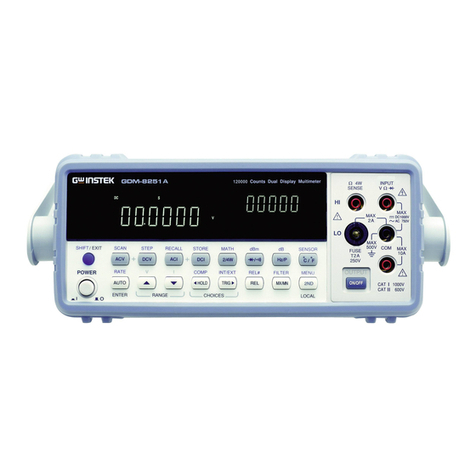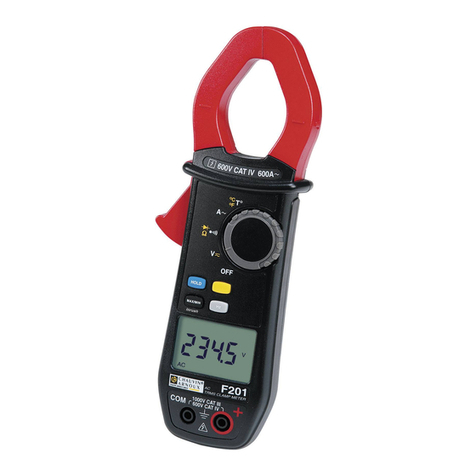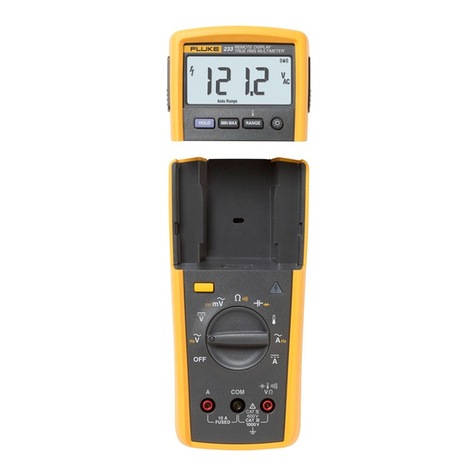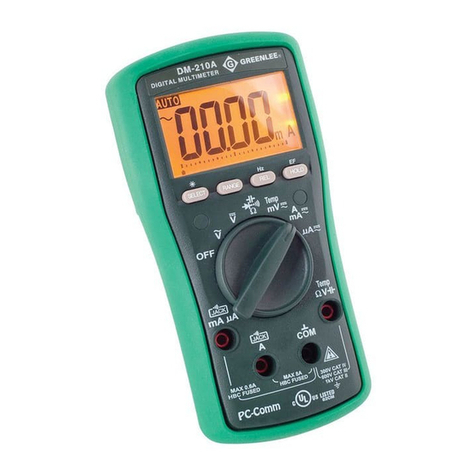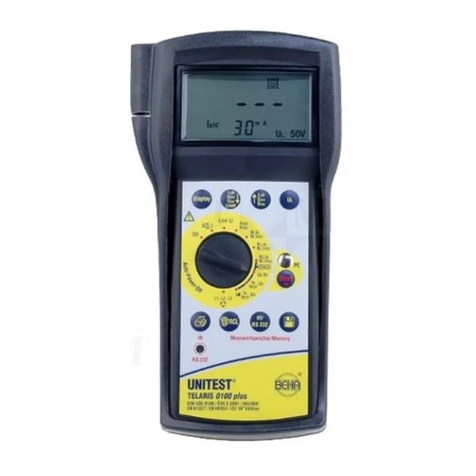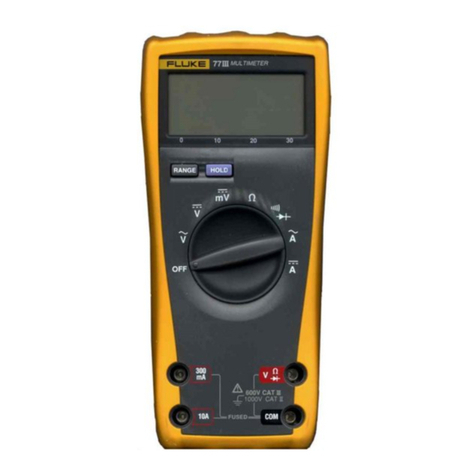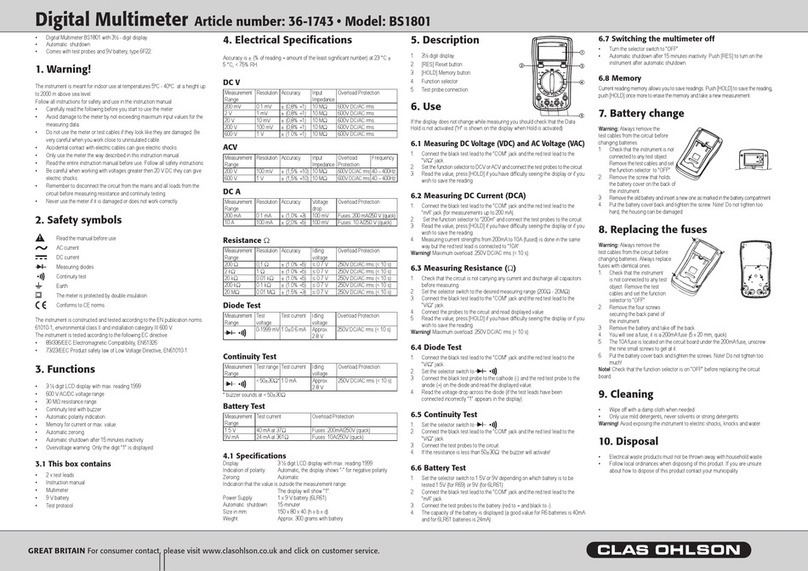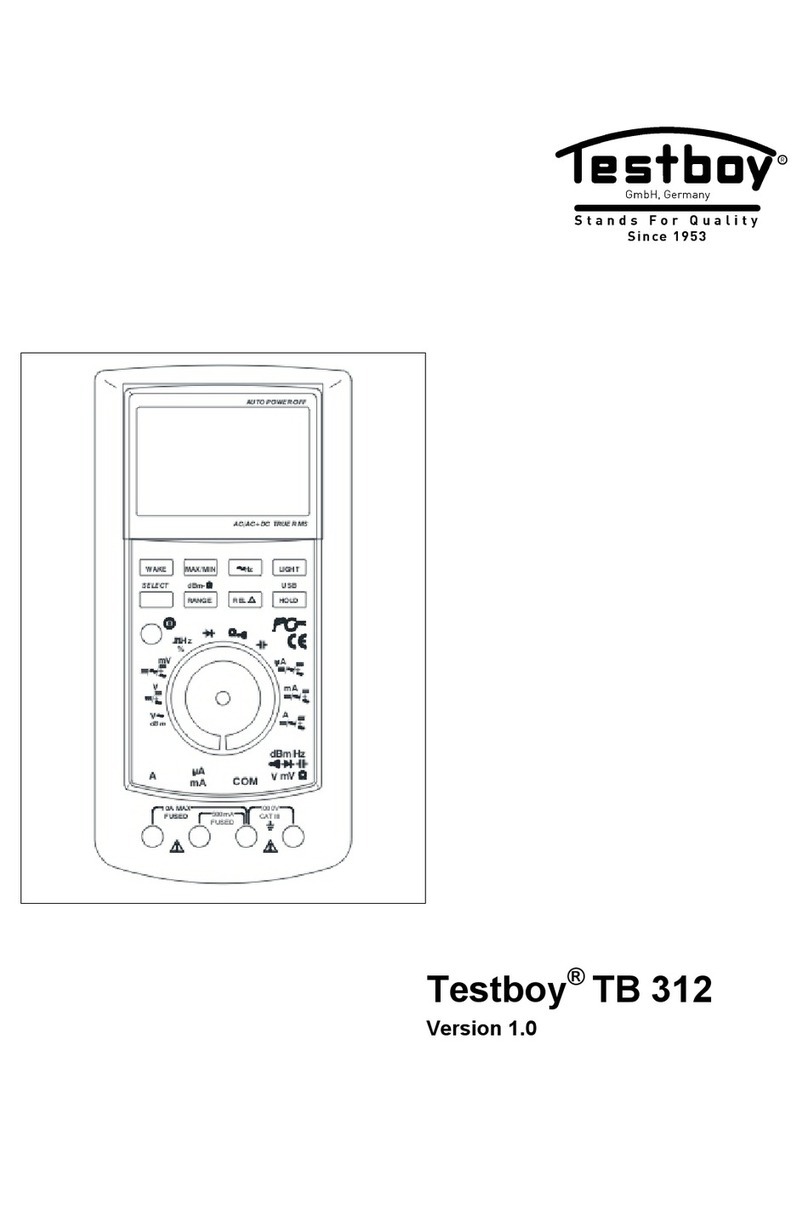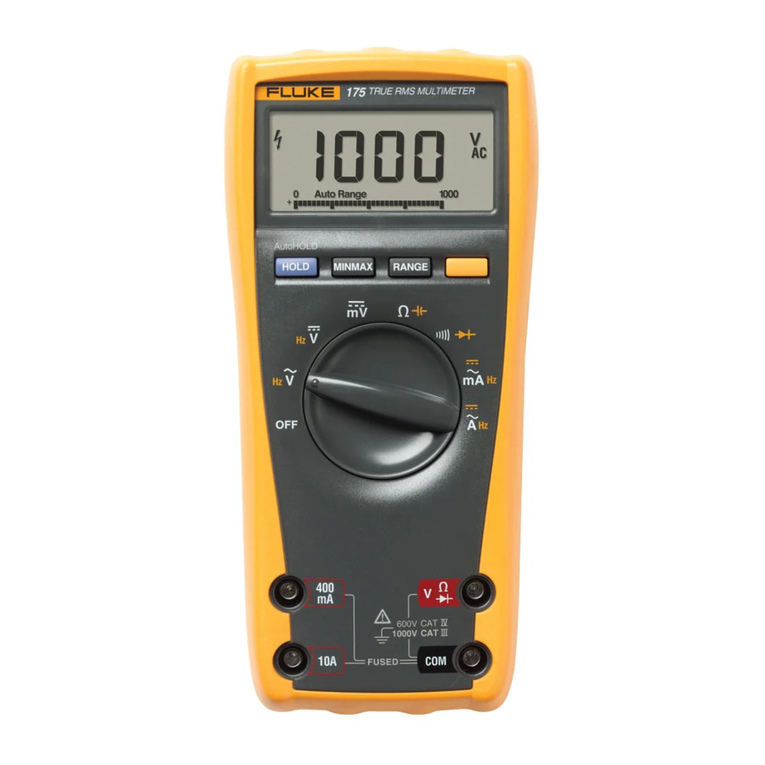Tintometer AQUALYTIC AL15 User manual

AL15
MultiMeter Instrument -
Instruction Manual
pH/ORP DO
CD/TDS
GB

Table of Contents
1. Specifications .............................................................................................1
1.1 General Specifications ................................................................................1
1.2 Electrical Specifications...............................................................................1
2. Front Panel Description...............................................................................4
3. pH/mV Measuring and Calibration Procedure .............................................5
4. Conductivity/TDS Measuring and Calibration Procedure..............................9
5. DO (Dissolved Oxygen) Measuring
and Calibration Procedure ........................................................................12
6. Data Load, Data Record, Data Logger.......................................................16
7. Advanced Adjustment Procedure..............................................................17
7.1 Check Memory Space...............................................................................18
7.2 Clear Memory ..........................................................................................18
7.3 Date/Time Setting ....................................................................................18
7.4 Sample Time Setting ................................................................................19
7.5 Auto Power Off Default Setting................................................................19
7.6 Temp. Unit Default Setting .......................................................................19
7.7 pH Manual Temp. Value Setting................................................................19
7.8 CD Temp. Compensation Factor Setting ...................................................19
7.9 CD ( µS, mS ), TDS ( ppm ) Setting............................................................20
7.10 DO % Salt Compensation Value Setting...................................................20
7.11 DO Height (Altitude) Compensation Value Setting....................................21
7.12 Escape from the Setting function .............................................................21
8. Data Output.............................................................................................31
9. RS232 PC Serial Interface .........................................................................22
10. Battery Replacement ................................................................................23
11. System Reset............................................................................................23
12. Accessories...............................................................................................24
13. Important information for pH electrodes ..................................................25

1
AL15
1. Specifications
1.1 General Specifications
Circuit Custom microprocessor LSI
Display LCD size : 58 mm x 34 mm
Measurement pH / Oxidation Reduction Potential (ORP)
Conductivity/Total Dissolved Solids (TDS)
Dissolved Oxygen (DO)
Temperature
Sampling Time of Data Logger
1 second to 8 hours 59 minutes and 59 seconds
Data-Hold Freeze the display reading.
Speicherfunktion Maximum- und Minimumwerte
Power off • Auto shut off saves battery life; manual shut off possible
by pressing “Power” button for 2 seconds
• Default changeable: auto power off/ manual power off
• With default set at auto power off, power will off
automatically after 10 minutes if no button is pressed.
Data Output RS 232 PC serial interface
Operating Temperature 0 to 50 °C (32 to 122°F) for the instrument (not including
probes)
Operating Humidity Less than 80% rel. humidity
Power Supply • DC 1.5 V with 4 batteries (mignon size; Type AA)
• DC 9 V by adapter input
Power Current • Operation: approx. DC 28 mA
• Clock (power off): approx. DC 1 µA
Weight • instrument 390 g (batteries included)
• with protective covering 620 g
Dimension • instrument: 203 x 76 x 38 mm
• with protective covering: approx.
220 x 125 x 45 mm
1.2 Electrical Specifications (23± 5°C)
A. pH/mV
Measurement pH 0 bis 14 pH
mV -1999 mV to 1999 mV
Input Impedance 1012 ohm
Temperature Compensation
for pH measurement
Manual 0 to 100°C (32 to 212°F)
Automatic
(ATC)
0 to 65°C
(32 bis 149°F) with temperature probe

2AL15
pH Calibration 11 to 3 point calibration using
pH 7 / pH 4 / pH 10 buffer solutions
Three point calibration ensures best linearity and accuracy.
Measurement Range Resolution Accuracy*
pH 0 bis 14 pH 0,01 pH ± (0,02 pH + 2 digits)
mV - 1.999 bis 1.999
mV
1 mV ± (0,5 % pH + 2 digits)
* pH accuracy is based on calibrated meter only.
B. Conductivity
Conductivity probe Carbon rod electrode for long life
Function • Conduction (µS, mS)
• Total Dissolved Solids (ppm)
• Temperature (°C, °F)
Temperature Compensation Automatic from 0 to 60°C (32 – 140 °F),
with temperature compensation factor variable
between 0 to 5 % per °C
Probe Operating Temperature 0 to 60 °C (32 to 140°F)
Probe Dimension Round, 22 mm diameter x 120 mm length
Probe Weight approx. 65 g
Range Measurement Resolution Accuracy
200 µS 0 bis 200,0 µS / cm 0,1 µS / cm ± (2 % F.S.
+ 1 digit)
2 mS 0.2 bis 2,000 mS / cm 0,001 mS / cm
20 mS 2 bis 20,00 mS / cm 0,01 mS / cm
200 mS 20 bis 200,0 mS / cm 0,1 mS / cm
F.S. = Full Scale

3
AL15
C. TDS (Total Dissolved Solids)
Range Measurement Resolution Accuracy
200 ppm 0 bis 132 ppm 0,1 ppm ± (2 % F.S. + 1 Stelle)
2.000 ppm 132 bis 1.320 ppm 1 ppm
20.000 ppm 1.320 bis 13.200 ppm 10 ppm
200.000 ppm 13.200 bis 132.000 ppm 100 ppm
F.S. = Full Scale
D. Temperature
Function Measurement Resolution Accuracy
°C 0 °C bis 60 °C 0,1 °C ± 0,8 °C
°F 32 °F bis 140 °F 0,1 °F ± 1,5 °F
E. Dissolved oxygen
Oxygen Probe Polarographic type oxygen probe
Probe Compensation
and Adjustment
Temperature 0 to 50°C, automatic,
(3 to 122 °F)
Salt 0 to 39 % Salt
Height 0 to 8900 meter
Probe Weight approx. 195 g
Probe Size Round, 190 mm length x 28 mm diameter
Measurement Range Resolution Accuracy (23 ± 5°C)
Dissolved Oxygen 0 to 20.0 mg/L 0.1 mg/L O2± 0.4 mg/L O2
Oxygen in Air 0 to 100 % 0.1 % O2± 0.7 % O2

4AL15
2. Front Panel Description (Fig. A)
A-1 Display
A-2 Power Button
A-3 REC Button (Enter Button)
A-4 HOLD Button (ESC Button)
A-5 Mode Button ( Up Button, Zero Button)
A-6 Function Button (Range Button, Down Button)
A-7 Send Button (Clock Button)
A-8 SET Button (Logger Button)
A-9 Stand
A-10 Battery Compartment Cover
A-11 Battery Cover Screw
A-12 Tripod Fix Nut
A-13 Temp. Socket (pH ATC Socket)
A-14 CD Socket
A-15 DO Socket
A-16 pH Socket (BNC Socket)
A-2
A-3
A-4
A-5
A-6
A-7
A-8
A-1
A-15
A-14
A-13
A-16
A-12
A-9
A-11
A-10

5
AL15
A-17 DC 9V Power Adapter Input Socket
A-18 RS-232 Output Terminal
A-19 System Reset Button
A-20 LCD Brightness Adjust
A-17 A-18 A-19 A-20
DC IN
RS232
RESET
Attention:
Please do not put more than one electrode only into the water sample when
using an instrument that works with various electrodes.
Only start the measurement for which the according electrode is immersed
in the sample.
The meter default settings are as follows:
• The display unit is set to pH.
• The temperature unit is set to °C.
• Manual temperature setting (without ATC probe connection)
• Auto power off.
• Data logger function sampling time: 2 seconds.
3. pH/mV-Messung und Justierung

6AL15
Display layout
Measurement Value
PH
Manual Temp.
25.0 °C
Temp. value
pH or mV
Temp unit
10.00
Manual Temp. or
Auto Temp.
3.1 pH measurement (with manual temperature setting)
1) Attach the pH Electrode by installing the “Probe Plug“ (Fig. B-1) into the “pH
Socket/BNC Socket“ (Page 4, Fig. A-16).
2) Power on the meter by pressing the “Power” button once.
3) Keep pressing the “Mode” button until the display of bottom right shows
“pH“ and “Manual Temp.“ indicator.
4) Adjust the Manual Temp. value exactly to the same temperature
as the
solution. For procedure refer to chapter 7.7, page 19.
5) Remove cap and hold the pH Electrode body (Fig. B-2) and completely im-
merse the “Sensing Head“ (Fig. B-3) in the solution to be measured and gently
swirl the probe.
6) The upper display will show the pH value, the bottom left display will show
the Manual Temp. setting.
Fig. B
B-1
B-2
B-3
B-4

7
AL15
3.2 pH measurement (with ATC , automatic Temperature Compensation)
1) All the procedures are the same as for 3.1 “pH measurement (manual temper-
ature setting)“, except for attachment of a temperature probe by inserting the
plug of the temperature probe into the “Temp. Socket“ (Page 4, Fig. A-13),
and immersing the sensing head of the temperature probe into the measure-
ment solution.
2) The upper display will show the pH value, the bottom left display will show
the Temp. value of the measured solution, and
the bottom right display
will show “Auto Temp.“ as example below:
When not in use the “Electrode Sensing Head“ (Page 6, Fig. B-3) should
always be immersed in water by part-filling the probe cap, (Page 6, Fig.
B-4) and ensuring that the cap is firmly lifted onto the probe. Failure to
do so will reduce probe life.
3.3 mV Measurement
The instrument has a built in mV (millivolt) measurement function, which enables
you to make ion-selective, ORP (oxidation reduction potential), and other precise
mV measurements.
1) Attach the ORP Electrode by installing the “Probe Plug“ of the
ORP electrode
into the “pH Socket/BNC Socket“ (Page 4, Fig. A-16).
2) Power on the meter by pressing the “Power” button once.
3) Keep pressing the “Mode” button until the display at bottom right shows
“PH“ and “Manual Temp.“ indicator.
Press the “Function” button once so that the bottom right display
shows “mV“ .
4) The upper display will show the mV value.
3.4 pH calibration
Calibration - Introduction
An “ideal” pH Electrode generates 0 mV at pH 7.00 (177.4 mV at pH 4). The
meter has been calibrated with signals which simulate the “ideal” pH Electrode
(based on 25°C ambient environment). However not every pH Electrode is as
accurate as the “ideal” one, so calibration procedures are necessary before first
time measurement. In addition to calibration before first time measurement,
users are also recommended to carry out regular calibration to ensure high ac-
curacy measurements.
PH
Auto Temp.
25.0 °C
7.01

8AL15
Required Equipment for Calibration
1) pH Electrode.
2) pH buffer solutions.
Calibration Procedure
1) Attach the pH Electrode by installing the “Probe Plug“ (Page 6, Fig. B-1) into
the “pH Socket/BNC Socket“ (Page 4, Fig. A-16).
2) Power on the meter, set the mode to pH measurement, and the bottom right
display will show “PH“ .
3) Adjust the “Temperature Compensation Value“ to make it the same tempera-
ture as the pH buffer solution.
• Manual temperature compensation value adjustment procedure,
refer to 7-7, page 19.
• Automatic temperature compensation, refer to 3.2, Page 7.
4) Hold the “pH Electrode body“ (Page 6, Fig. B-2) and completely immerse the
“Sensing Head“ (Page 6, Fig. B-3) in the buffer solu
tion and gently swirl the
probe. The display will show the pH value.
5) Press the “REC” button and “HOLD” button at the same time. The display will
show the following screen as an example. Now release.
PH CAL.
^, v Enter : Y
23.5 °C
7.00
6) • If the buffer solution is pH 7.0 (± 1 pH), the upper display will show 7.00
automatically.
• If the buffer solution is pH 4.0 (± 1 pH), the upper display will show 4.00
automatically.
• If the buffer solution is pH 10.0 (± 1 pH), the upper display will show 10.00
automatically.
• If the buffer solution value is beyond pH 7.00, pH 4.00, pH 10.00 (for
example 7.01, 4.02, 10.03) then use
“ ” button, “ ” button to adjust the display value to exactly match the pH
buffer solution value.
7) Press the “Enter” button twice to save the calibration data and finish the
calibration procedure.

9
AL15
8) The described procedure can be performed for the following calibration
points:
pH7 calibration
pH4 calibration
pH10 calibration
• Calibration should always start with pH7, followed by pH4 and / or pH10
calibration.
• Rinse the electrode with distilled water before each calibration point.
• Repeat the above calibration procedures at least twice to ensure accuracy.
3.5 ORP calibration
1) Attach the ORP electrode (optional, ORP-14) by connecting the ORP electrode
to the meter.
2) Power on the meter, and set the mode and function to “mV“ (refer to chapter
3.3, Page 7).
3) Immerse the sensing head of the ORP electrode in the ORP standard buffer
solution. The upper display will show the ORP value in mV.
4) Press the “REC” button and “HOLD” button at the same time. The display
will show the following screen as an example. Now release.
5) Use “ ” button, “ ” button to adjust the upper display value to exactly
match the ORP buffer solution value. Press the “Enter” button twice to save
the calibration data and finish the calibration procedure.
• ORP calibration is only possible if the ORP buffer solution
value is > 100 mV.
• ORP calibration at less than 100 mV is not permitted.
mV
Adjust
201
235
Aiv
The meter default settings are as follows:
• The display unit is set to conductivity (µS, mS).
• The temperature unit is set to °C.
• Temp. compensation factor is set to 2.0% per °C.
• Auto range.
• Auto power off.
• Data logger function sampling time:
2 seconds.
4. Conductivity/TDS Measuring and Calibration

10 AL15
4.1 µS, mS measurement
1) Attach the Conductivity Probe by installing the “Probe Plug“ (Fig. C-1) into the
“CD Socket“ (Page 4, Fig. A-14).
2) Power on the meter by pressing “Power” button once.
3) Keep pressing the “Mode” button until the bottom right display shows a
value (e.g. “200 mS“) and “Auto Range“.
4) Remove probe cap and hold the probe body (Fig. C-2) and completely im-
merse the “Sensing Head“ (Fig. C-3) in the solution to be measured. Swirl the
probe to let any air bubble escape from the sensing head.
5) The display will show the conductivity values in either “mS / cm” or “µS/ cm”.
At the same time the bottom left display will show the Temp. value of the
measured solution.
Fig. C
C-1
C-2
C-3
Display layout Measurement Value
200.0 µS
Auto Range
24.2 °C
Temp. value Temp unit Auto or Manual
range
19.00
Range
scale

11
AL15
Manual range operation
The meter default is set to auto range mode. Under auto range measurement,
the bottom right display will show the “Auto Range“ indicator. If manual range
mode is required, the procedures are as follows:
1) Press the “Range” button continuously for at least two seconds until the
bottom right display shows the “Manual Range“ indicator. Release the
“Range” button. Now the meter is set for manual range operation.
2) Press the “Range” button once to change the range. The range (200 µS,
2 mS, 20 mS, 200 mS) will show under the measurement value.
3) • If the display shows “ ---- “, it indicates an overrange.
Select the next, higher range.
• If the display shows “ ---- “, it indicates an underrange.
Select the next, lower range.
4) To change Manual Range back to Auto Range, press the “Range” button
continuously for at least two seconds until the bottom right display shows the
“Auto Range“ Indicator. Release the “Range” button. Now the meter is set for
Auto range mode again.
Change the Temp. unit to °F
To change the Temp. unit from °C to °F, please refer to page 19, chapter 7.6
(Temp. Unit Default Setting)
Change the Temp. Coefficient Factor
The default Temp. compensation factor value of the measurement solution is
set to 2.0% per °C. To change it, please refer to page 19, chapter 7.8 (Temp.
Compensation Factor Setting).
4.2 TDS (ppm) measurement
Measuring procedures are the same as above 4.1 Conductivity (µS, mS) meas-
urement, except for changing the display unit from µS, mS to ppm. For detailed
procedures please refer to page 20, chapter 7.9 CD (µS, mS), TDS (ppm) Setting.
4.3 Calibration
1) Obtain a the standard conductivity solution:
For example :
• 2 mS range calibration solution :
1.413 mS Conductivity Standard Solution
• 200 µS range calibration solution :
80 µS Conductivity Standard Solution
• 20 mS range calibration solution :
12.88 mS Conductivity Standard Solution
or other Conductivity Standard Solution.

12 AL15
CD CAL.
^, v ENTER: Y
23.5 °C
1.413
2) Install the “Probe Plug“ (Page 14 Fig. C-1 ) into the “CD Socket“
(Page 4, Fig. A-14).
3)
Power on the meter, and set the mode to conductivity measurement (µS, mS ).
4) Hold the probe body (Page 10, Fig. C-2) and completely immerse “Sensing
Head“ (Page 10, Fig. C-3 ) in the standard solution. Swirl the probe to let any
air bubble escape from the sensing head. The display will show the
conductivity mS ( mS ) values.
5) Press the “REC” button and “HOLD” button at the same time. The display will
show the following screen, as an example. Now release.
6) Use “ ” button (Page 4, Fig. A-5), “ ” button to adjust the upper display
value to match the standard conductivity value.
7) Press the “Enter” button twice to save the calibration data, and finish the
calibration procedure.
• If only one calibration point is needed, just set the 2 mS range
(1.413 mS Cal.).
• A multi-point calibration procedure should always start with 2 mS
range (1.413 mS Cal.), then proceed to other ranges (20 µS range,
20 mS range or 200 mS range) if necessary.
ATTENTION: Make sure the Oxygen probe is filled with Electrolyte!
To fill the Probe‘s Electrolyte, refer to chapter 5.3 “Probe maintenance“,
page 15.
The meter default settings are as follows:
• The display unit is set to % O2.
• The temperature unit is set to °C.
• Auto power off.
• Data logger sampling time: 2 seconds.

13
AL15
5.1 Dissolved Oxygen measurement
Fig. D
1) Attach the Oxygen Probe by installing the “Probe Plug“ (Fig. D-1) into the
“DO Socket“ (Page 4, Fig. A-15).
2) Power on the meter by pressing the “Power” button once.
3) Keep pressing the “Mode” button until the bottom rigth display shows
“%O2“.
CAUTION! Ensure calibration on air before measurement.
Wait approx. 2 minute until the reading value stabilises.
If the reading value on air is not within 20.7 to 21.1 (20.9 ± 0.2), then
proceed with calibration procedures first. For calibration procedures,
please refer chapter 5.2, page 14.
After completing the calibration procedures, the display should show a
value between 20.8 and 21.0 (20.9 ± 0.1).
4) Press the “Function” button once, and the bottom right display will show
“mg/L“. Now the meter is ready for the Dissolved Oxygen measurement.
D-1D-2
D-3
D-5
D-4
Display layout Measurement Value
% O2
24.2 °C
Temp. value Temp unit Temp. unit
% O2or mg/L
20.9

14 AL15
5) • Remove the protective cover from the probe head and immerse the probe
to a depth of at least 10 cm in the measured liquid in order for the auto
matic temperature compensation to take effect.
• Thermal equilibrium must occur between the probe & the measurement
sample, which usually takes to a few minutes if the Temp. difference
between the two is only a few degrees Celsius.
• To measure the dissolved oxygen content in any given liquid, it is sufficient
to immerse the tip of the probe in the solution, making sure that the veloci-
ty of the liquid coming into contact with the probe is at least 0.2 - 0.3 m/s.
This is achieved by swirling the probe in the solution.
• During laboratory measurements, the use of a magnetic stirrer/ agitator is
recommended. In this way, errors due to air diffusion in the solution are
reduced to a minimum.
6) The display will show the Dissolved Oxygen values (mg/L). At the same time,
the bottom left display will show the Temp. value of the measured solution.
7) Rinse the probe carefully with normal tap water after each series of measure-
ments.
Oxygen in the air
When the display unit shows “%O2“, this represents an approximate air Oxygen
value.
Changing the Temp. unit to °F
To change the Temp. unit from °C to °F, please refer to page 19, chapter 7.6
(Temp. Unit Default Setting).
“% Salt“ compensation value adjustment
To change the % Salt compensation value, refer to page 20, chapter 7.10 (%
Salt Compensation value Setting).
“Height“ (Altitude) compensation value adjustment
To change the Height compensation value, please refer to page 20, chapter 7.11
(Height Compensation value Setting).
5.2 Calibration
1) Install the “Probe Plug“ (Page 13, Fig. D-1) into the “DO Socket“
(Page 4, Fig. A-15).
2) Power on the meter by pressing the “Power” button once.
3) Keep pressing the “Mode” button until the bottom right display shows
“%O2“.
Wait for at least 5 minutes until the display reading values stabilise
with no fluctuation.

15
AL15
4) Press the “REC” button and “HOLD” button at the same time. The display will
show the following screen, as an example. Now release.
5) Press the “Enter” button twice. This will save the calibration data and finish
the calibration procedure. Finally the lower display will show “O2 CAL. OK“.
Return to the normal screen. The complete calibration procedure will take
approximately 30 seconds.
Calibration - additional information:
As oxygen in air is typically 20.9 %, use ambient air 02for quick &
precise calibration.
5.3 DO Probe maintenance
a) First time use of the meter:
To keep the DO probe in the best condition, be sure to fill the Oxygen Probe,
with Electrolyte prior to first use.
b) After using the probe for a certain period:
If the user cannot calibrate the meter properly or the meter‘s readings are not
stable, please check the oxygen probe to see if the electrolyte in the probe
head container has run out or the diaphragm (inside the probe head) has a
problem (e.g. is dirty). If yes, please fill the electrolyte or change the dia-
phragm set. Then re-calibrate.
Diaphragm (probe head including diaphragm set):
A key component of the oxygen probe is the thin Teflon diaphragm housed in
the tip of the probe. This diaphragm is permeable by oxygen molecules but not
by the considerably larger molecules contained in the electrolyte. Accordingly
oxygen may diffuse throughout the electrolyte solution contained in the probe,
and its concentration may be quantified by the measurement circuit. This sensi-
tive diaphragm is rather delicate and is easily damaged if it comes into contact
with solid objects or is subjected to knocks. If the diaphragm is damaged or the
electrolyte has run out, please see following procedure:
O2 CAL.
ESC:N ENTER: Y
23.5 °C
20.9

16 AL15
1) Unscrew the “Probe Head“ (Page 16, Fig E-3).
2) Pour out the old Electrolyte from the container in
the “Probe head“.
3) Fill the container with new Electrolyte.
4) Screw the probe head (Fig E-3) back onto the
probe body.
5) When not in use, insert the probe head into the
probe protection cover (Page 13, Fig. D-5) that is
equipped with a wet sponge.
6. Data Load, Data Record, Data Logger
6.1 Data Hold
During the measurement, press the “Hold” button once to hold the measured
value and the LCD will display a “HOLD“ symbol. Press the “Hold” button once
again to release the data hold function.
6.2 Data Record (MAX, MIN reading)
1) The data record function records the maximum and minimum readings. Press
the “REC” button once to start the Data Record function and a “REC“ symbol
will be displayed.
2) With the “REC“ symbol on the display:
a) Press the “REC” button once more. The “REC MAX“ symbol along with the
maximum value will appear on the display. To delete the maximum value,
just press the “Hold” button once. The display will then show only the
“REC“ symbol and the meter will continue to record data in the memory.
b) Press the “REC” button again. The “REC MIN“ symbol along with the mini-
mum value will appear on the display. To delete the minimum value, just
press the “Hold” button once. The display will then show only the “REC“
symbol and the meter will continue to record data in the memory.
c) To exit the memory record function, just press the “REC“ button for at least
2 seconds. The display will revert to the current reading.
Probe Electrolyte
Probe head including
Diaphragm set
E-1
E-2
E-3
Fig. E
E-1 Probe body
E-2 Temp. sensor
E-3 Probe head

17
AL15
6.3 Data Logger
The data logger function can save 16,000 readings with time and date. (Real
time data logger with built-in-clock (hour-min-sec., year-month-date)).
Der Ablauf für die Datenerfassung ist wie folgt:
The data logger procedure is as follows:
a) Pushing the “Logger” button once will show the sampling time value on the
bottom left display then disappeared.
b) Press the “REC” button once to start the Data Record function and a “REC“
symbol will be displayed.
c) Auto Data Logger
The Sampling frequency can be set from 1sec to 8h 59min
59sec (refer to chapter 7.4 page 19). E.g.: If a sampling fre-
quency of 1 min is set, the meter stores the measured value
every minute until the data logger function is stopped. Press
the “Logger” button once to start the Auto Data Logger
function, at the same the bottom right display will show the
indicator “Recording....“. Now the Data Logger function has
started. The upper display will show a “DATA“ indicator along
with “REC“ marker.
Press the “Logger” button once to stop the data
logger function. The “DATA“ indicator will disappear. If you
press the Logger button once more the Data Logger function
will restart.
d) Manual Data Logger (Sampling time is set to 0 second). Please refer to
chapter 7.4 page 19. Press the “Logger” button once to save one set of data
in the memory. At the same time the bottom right display will flash the indica-
tor “Recording....“. Now the Data logger function has started. The upper
display will show the “DATA“ indicator along with the “REC“ marker.
e) Memory full
With the data logger in action, if the bottom right display shows “Full“, it
indicates the memory has over 16,000 sets and is therefore full.
• To find out the Free Memory, please refer to chapter 7.1, Page 18.
• To clear the memory of data, please refer to chapter 7.2, Page 18.
7. Advanced Adjustment Procedures
Before carrying out the following Advanced Adjustment Procedures exit the
“Hold function“ and the “Record function“ first. The display will not show the
“HOLD“ and the “REC“ marker.
1) Press the “SET” button for at least two seconds until the lower display shows:
XXXXX Memory Space
Push the “ESC” button to return to the normal measuring display.
25.5°C 2.000 mS
AutoRange
25.5°C 2.000 mS
AutoRange
REC DATA

18 AL15
2) To select “Advanced Setting Function”, press and hold the SET button, then
press again to successively show the following:
7.1 Memory Space
7.2 Clear Memory
7.3 Date/Time Set
7.4 Sample Time
7.5 Auto Power Off
7.6 Temp. Unit
The following functions appear only if the corresponding measurement function
is selected (pH, CD, DO)
7.7 M. TEMP. SET (pH mode)
7.8 Temp. Comp. (CD mode)
7.9 CD, TDS Select (CD mode)
7.10 % Salt SET (DO Mode)
7.11 Height Value (DO Mode)
7.12 ESC-> Finish
3) To make advanced Adjustments, use the following buttons:
“ESC”, “Enter”, “ ” Up, “ ” Down, “SET”.
7.1 Check Memory Space
To check the free memory, press and hold the SET button for at least 2 seconds.
The display will show.
XXXXX Memory Space
XXXXX is the free memory balance. For example XXXXX=15417.
7.2 Clear Memory
To delete readings from the memory:
• Push ENTER button twice to confirm.
• Press the ESC button once to quit, and return to the main measurement
display.
7.3 Date/Time Setting
• Use “ ” Up, “ ” Down and “Enter” (->) to set the Date (year-month-date)
and the Time (hour-min-sec).
Table of contents
